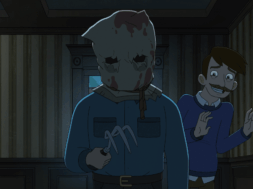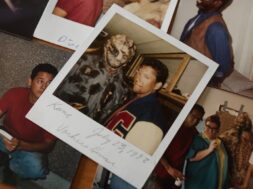Imagine you are at home. You go outside and you start watching the buildings in front of you. Look deep into the details: the houses, departments, maybe some clothes stores, one restaurant, and a pub on the corner. The second house from the left has two big windows, one next to the other. This rather insignificant detail stays in your mind, because of reasons.
Now turn back, you forgot to pick up your mobile phone. You return your view to the street again and now the house has one window. “That’s funny,” you think, “I’m sure there were at least two windows there”. When you cross the street, you notice the pub on the corner is gone, too. You start grabbing your head with both hands. Something’s wrong. You turn around, decide it’s time to go home, lock every damn door and stay in bed. But guess what: your house isn’t in the place it’s supposed to be. Now it’s on the next street, on your right, with the same white walls and black roof. For some unfathomable reason this is happening, and you can’t do anything to change it.
When you start your short but intense ‘journey’ in FAITH, an indie horror game with a retro ZX Spectrum visual style, the sensation of everything moving happens in your first few steps. You leave your car in the middle of a highway and you walk into a forest. Each scene has some trees and maybe an object of interest, like a small fountain. Reaching the end of the current scene, you get into a new one and see yet more trees, this time with some rocks around. You think you should have tried another direction before, so you go back from where you originally came to find out that the fountain is gone and the trees are displayed differently. The screens change randomly, so does the way to the destination. If you add a huge and horrendous white spider which screams in Latin coming for you every now and then, the recipe for a small mental breakdown is right there.

Being in a maze or a non-linear path with an unclear destination could be a stressful activity itself. But if the maze is also changing while you are going through it, it’s madness. Our sense of direction can help us find the way to go, or at least make us feel secure about where we are standing on space. The lack of visual references eliminates this feeling of security, and anxiety begins to rise. Where to go now? Why are these puddles here? I was here a moment ago. What is this shriveled tree doing there? Luckily enough for us, this “section” doesn’t last long, when we find the mansion and its key we can stop listening to that terrifying music and tell that displeasing spider to go to hell.
Inside the mansion, this continuous change of perception doesn’t exist. The orange rooms, with small ‘touches’ of other colors in specific objects, are fixed. However, you have another resource for fear and restiveness. You are searching for Amy, the daughter of a couple who has been possessed by some evil spirit. ‘Nobody’ is home apparently, but you can feel a presence wandering around. In certain moments you will see two brief ‘cutscenes’ which show you the spirit in first person. The disturbing effect it produces is almost tangible. Aghast I walked between rooms when I was attacked and immediately killed. Then the cutscene started again. I reached another room, and was again slaughtered by this spirit. The same five seconds of cutscenes played again. This cycle repeated itself, again and again.
Usually, when you see a specific scary image or experience a unique jump scare, the effect produced starts decreasing as you see it repeatedly. You get used to the stimulus –this is called Habituation. Nevertheless, I never stopped feeling nervous every time I watched the cutscene. Was it because of the briefness of the moment? Maybe the image itself is disturbing enough and it doesn’t get old? The music and sounds wrapping the moment? No, it’s none of these possible answers. Actually, it’s a more deep and disturbing feeling: the sense of despair created by inevitability.

“Wait a moment”, you may exclaim. “You are speaking about a ‘game over’ scene, one that can be easily be avoided by just not getting killed”. Yes, you are right, my dear reader. However, that’s not specifically what I’m thinking about. You see, there are five different endings in FAITH. Without getting too much into spoilers’ territory, almost all of these endings have a tragic outcome. Only one has a kind of positive vibe, but when you think about the bigger picture, it’s more ambiguous than anything. How can we stop another possession like Amy’s before happening? How can we be sure this evil spirit won’t appear again, anytime soon? What’s the point in trying to stop it again, anyway? When you are in a cyclic journey and events begin to repeat themselves, even before you reach the “beginning” of the cycle, it’s hard not to feel a little lost. Both the first forest scene and these reiterative cutscenes made me wonder: what if we are doomed to repeat the same thing over and over again? We are trapped in this cycle, and maybe there isn’t a way out.
I honestly don’t know. Maybe the upcoming sequel of FAITH will tell us a different story.
FAITH is available on PC via itch.io









